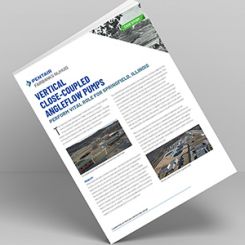Note from Terry Henshaw:
This is the first in a year‑long series of articles called Understanding NPSH. I have been intrigued by NPSH since my first significant exposure to pumps in the mid‑1950s. During the years, I have performed NPSH tests on centrifugal and reciprocating pumps, confronted numerous NPSH problems in the field and had numerous discussions on this intriguing and often confounding subject with engineers, technicians, operators and maintenance personnel. I have read numerous letters, articles and technical papers on NPSH. Some have been enlightening, some have been shallow and some have contained significant misinformation.
NPSH characteristics have been a major consideration in all the pumps that I have designed and a cornerstone of all the pump courses that I have taught.
The purpose of these articles is to draw together that available knowledge that is reasonable, logical and hopefully useful to those who select, apply, operate and/or troubleshoot pumps and dispel some of the numerous misconceptions about NPSH.
Importance
NPSH (or net positive suction head) is a subject of extreme importance in all pumping systems. It has been estimated that 80 percent of all pump problems are due to inadequate suction conditions, and most suction problems are related to NPSH. (Either the system does not provide as much as anticipated, or the pump requires more than anticipated.) It is therefore probable that most pump problems are NPSH problems.
The Extent of Our Knowledge Today
Early in the 20th century, all we knew about the limitation of pump inlet conditions was that there was a maximum lift that could exist on the suction side of a pump. We learned that the maximum lift varied with pump size, speed and capacity.
Through the last century, our understanding expanded to include the concepts of NPSH, suction specific speed, suction recirculation and minimum continuous capacity. We have also learned to recognize all the damage that can be done to a pump by inadequate inlet conditions.
Although our attention has been primarily focused on centrifugal pumps, our knowledge of the NPSH characteristics of rotary and reciprocating pumps has also increased.
Although our knowledge of NPSH (and related suction‑side phenomena) has increased significantly, there is still much we do not know about the subject. We still have a lot to learn.
What Happens When a Pump Cavitates?
If at any time, at any point, the static pressure on a liquid drops below vapor pressure, a portion of the liquid will boil-it will flash to a gas. This formation of gas bubbles is called cavitation. (Cavities form in the liquid.) Such gas formation, in a suction pipe or inside a pump, may cause a reduction in pump capacity and/or head. It may also cause damage to the pump. As liquid flows into any pump, there is a reduction in pressure. In a centrifugal pump, the liquid accelerates into the eye of the impeller, causing a reduction in pressure. The impeller vanes then slice into the liquid, creating zones of lower pressure. If a sufficient pressure margin, over vapor pressure, is not provided at the pump inlet, some of the liquid will flash at the leading edge of each vane.
With displacement pumps, the situation is similar. Because the pressure drops as the pumpage moves into the pumping chamber, suction pressure must exceed vapor pressure by some margin to prevent cavitation.
Even though the liquid is cavitating, we usually say that the pump is cavitating.
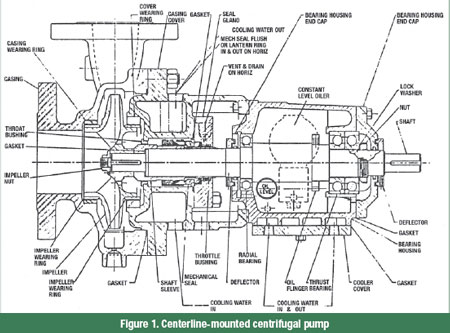
Figure 1 shows a horizontal, centerline‑mounted, API 610‑type centrifugal pump. The liquid end of the pump is to the left. The suction nozzle is also to the left. The impeller faces left. The "eye" of the impeller is that circular entrance to the impeller. Just to the right of the eye are the impeller vanes. It is at the leading edges of these vanes that cavitation will first appear.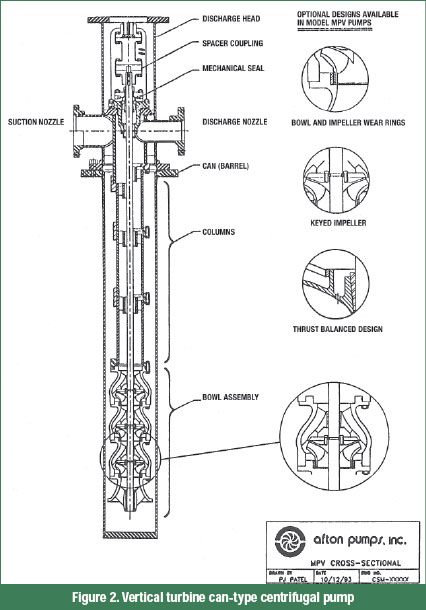
Figure 2 is a vertical turbine, can‑type centrifugal pump. All impellers face downward. The first‑stage impeller is at the bottom. It is the first stage impeller that will cavitate if suction pressure is insufficient.
Figure 3 is a horizontal reciprocating power pump. The liquid end is to the left. The suction valve, being merely a check valve, must be opened by suction pressure. If the suction pressure is not sufficiently above vapor pressure, the pumpage will flash as it flows past the suction valve, or flashing will occur at the face of the plunger as it moves to the right on the suction stroke.
Effects of Cavitation on All Pumps
Noise
Noise is a common characteristic of a pump suffering from insufficient NPSH. The noise is greater if the pumpage is cool water. Centrifugal and rotary pumps emit a crackling sound-as if the pump were pumping gravel. Cavitation in a reciprocating pump causes a knocking sound. In a power pump, the shock wave travels through the plunger, extension and crosshead, and emanates from the power end, often causing an operator or mechanic to incorrectly diagnose the problem as a loose rod or a chipped gear tooth.
Head and/or Capacity Loss
A centrifugal pump subjected to cavitation will often experience a reduction in head, which usually causes a reduction in capacity. A displacement pump subjected to cavitation will usually experience a capacity reduction, which may cause a reduction in discharge pressure. It should be noted, however, that a centrifugal or displacement pump can experience some cavitation without exhibiting a reduction in capacity or pressure.
Damage from Cavitation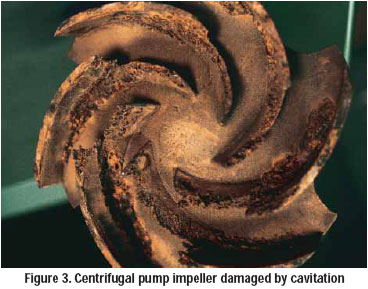
More serious than a degradation in performance is the damage that often results from cavitation. It is not the formation of the bubbles that causes damage. Damage is caused to pump parts when the bubbles collapse or "implode." When the bubbles collapse on a hard surface, they create a high pressure. Graber [1] stated that water vapor implodes with a pressure of 12,000 atmospheres (about 180,000-psi). The repeated hammering of a small area of metal with such pressure causes the eventual failure of the metal by compressive fatigue [2]. Tiny particles are broken away from an impeller, as shown in Figure 4, or from a rotary pump gear, as shown in Figure 5. These gears operated just a few hours under severe cavitation. In a reciprocating pump, the face of the piston or plunger usually experiences the most cavitation damage.
In addition to damage to the pumping elements, cavitation often causes damage to casings in centrifugal and rotary pumps. Power ends are not immune either. In all pumps, bearing life can be shortened. In centrifugal pumps, the life of a mechanical seal can also be shortened. In power pumps, severe cavitation can contribute to the failure of a fluid cylinder, crankshaft or gear.
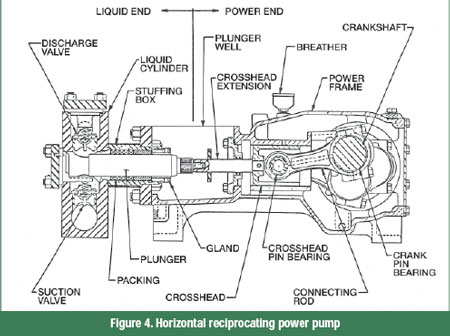
It should be noted that gas (such as air) flashing out of solution causes negligible pitting damage to liquid end parts, but in a reciprocating pump, it may cause damage to both liquid end and power end components because of the shock forces created during the pumping cycle. Free gas has been known to cause forged stainless steel fluid cylinders to fracture [3].
References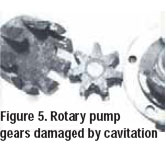
- Graber, P., "Solids Handling Pumps ‑ Part 2," World Pumps, 1983
- Stapanoff, A. J., Centrifugal and Axial Flow Pumps, John Wiley & Sons, Inc., 1948
- Henshaw, Terry L., Reciprocating Pumps, Van Nostrand Reinhold Co., Inc., 1987
Pumps & Systems, February 2009

